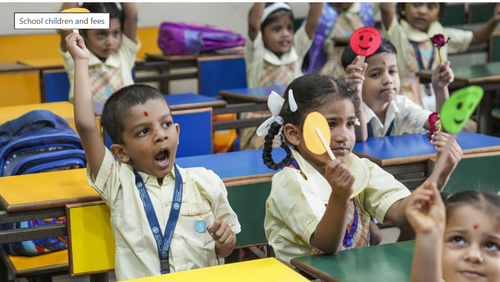From local wisdom to global solutions: The role of climate change education in a changing world
By Kartikeya Sarabhai Updated: September 23, 2025
https://www.theweek.in/education/latest/2025/09/23/from-local-wisdom-to-global-solutions-the-role-of-climate-change-education-in-a-changing-world.html 21:00 IST
As climate change increasingly becomes a part of people's reality, whether it is experiencing floods, droughts, unseasonal rains, or record temperatures, it is important that people understand these phenomena and what they can do about them. Climate change education (CCE) is shifting from awareness to understanding to action. Climate change education needs to be integrated within a broader understanding of the environment and sustainability. Climate change is not an isolated issue; it is inextricably linked to other planetary crises, especially pollution, biodiversity loss, and people’s lifestyles. Students must fully grasp the interconnectedness of the micro and macro ecological systems. Traditionally, cultures evolved ways in which they lived in harmony with their environment, and there are many lessons from traditional practices. Integrating learnings from the traditional knowledge systems into the curriculum can be effectively used in schools. This also allows developing a pedagogy that links the school to the community. The world is also rapidly seeing a rise in innovative solutions to mitigate the impacts of climate change. There is an increased opportunity for children themselves to become innovators, with their creativity and fresh perspectives, young people can design modern solutions in building a more resilient environment. Before addressing the quality of climate education, there is a stark reality that needs to be addressed. Over 260 million children are still out of school worldwide. This is especially true in regions facing political, climatic, or social barriers. In South Asia alone, millions of children are not able to continue and finish their education. Beyond these educational challenges, we face another changing reality: the evolving nature of global leadership and international cooperation. After World War II, there was a strong belief that national and global interests could align, leading to the creation of institutions like the United Nations and, within it, the United Nations Environment Programme (UNEP) and the conventions on climate change, biodiversity and combating desertification. This led to agreements such as the Sustainable Development Goals (SDGs) and the Paris Accord in 2015. That year certainly marked a high point in global cooperation on evolving solutions to global environmental challenges. The spirit of this is reflected in many curriculums and, of course, in global citizenship in education as well as ESD. However, in recent years, there's been a noticeable shift. Many nations are increasingly focusing on making a distinction between their self-interests and global goals. This trend away from global thinking poses a challenge when young children learn about issues like climate change, which cannot be solved without such cooperation. While they are, of course, citizens of their communities, their city, their state and their nation, they also need to understand that they must act like responsible citizens of the planet. Climate change mitigation requires collective action across countries. In India, the integration of environmental education into the national curriculum has a long history. National Educational Policies over the years have progressively tried to create curriculums which make children aware of environmental issues. A landmark moment came in the early 1990s, with a Supreme Court judgment that mandated environmental education be included in all formal education from K-12 and beyond. Rather than treating it as an add-on subject, environmental themes were integrated across the curriculum—in sciences, social sciences, and more. A few years before that, in 1984, the government recognised the critical role education would have to play in bringing about transformation towards sustainability in India. This led to the establishment of the Centre for Environment Education (CEE) as a Centre of Excellence by the Ministry of Environment and Forests. It was tasked with facilitating and promoting innovative EE and ESD relevant to India, but being at the critical forefront of the field, working alongside various partners to infuse environmental education, ESD, and CCE into the formal educational system and beyond.
Today, when new textbooks and learning materials are being developed under the NEP 2020 and NCF 2023, and a compulsory environmental education subject is being introduced at the 10th Grade, there is a great opportunity to transform the system. Another opportunity for EE comes from countries setting ambitious goals under UN conventions. For instance, India has taken the goal of massive expansion in renewable energy - such as creating a capacity of 500 gigawatts of renewable energy by 2030 - and a broader push into a circular economy, waste management, and other sustainability fields. It is estimated that 35 million green jobs will be needed by the time the nation celebrates its 100th year of independence in 2047. These green jobs will span across a wide range of sectors - from more organised and professionalised roles in waste segregation and recycling, to careers in renewable energy, energy-efficient manufacturing, sustainable agriculture, biodiversity conservation, and even sustainability education itself. The transition to a green economy will not just require engineers and scientists, but also community workers, educators, designers, and all of whom need to understand and have the skills to integrate sustainability into the fields they are working on.
Therefore, we need to start at the school level with hands-on learning and real-life problem solving and critical thinking, which encourages direct action - whether through community-based projects, eco-entrepreneurship, and local conservation efforts. When students engage in real-world sustainability initiatives, they begin to see that their actions matter. They do not just learn about climate change - they learn how to respond to it, take Handprint actions, shape a more sustainable future, starting from their own schools and communities. In doing so, education becomes a bridge - not only to employment, but to meaningful participation in the building of a greener, fairer world.
* I want to thank Nikita Iyer, Project Officer, CEE, for her help with the article.
 Forget Password?
Forget Password?
 Forget Password?
Forget Password?
